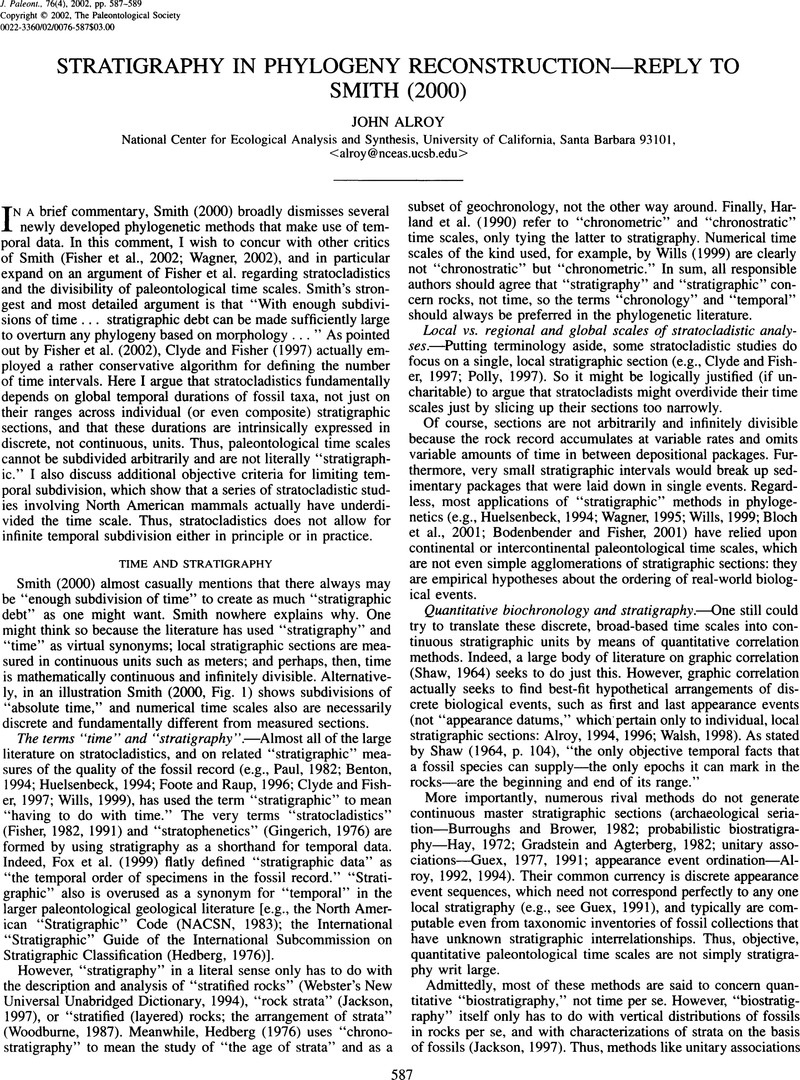No CrossRef data available.
Article contents
Stratigraphy in phylogeny reconstruction—reply to Smith (2000)
Published online by Cambridge University Press: 14 July 2015
Abstract
An abstract is not available for this content so a preview has been provided. Please use the Get access link above for information on how to access this content.

- Type
- Comment and Reply
- Information
- Copyright
- Copyright © The Paleontological Society
References
Alroy, J.
1992. Conjunction among taxonomic distributions and the Miocene mammalian biochronology of the Great Plains. Paleobiology, 18:326–343.CrossRefGoogle Scholar
Alroy, J.
1994. Appearance event ordination: a new biochronologic method. Paleobiology, 20:191–207.CrossRefGoogle Scholar
Alroy, J.
1996. Constant extinction, constrained diversification, and uncoordinated stasis in North American mammals. Palaeogeography, Palaeoclimatology, Palaeoecology, 127:285–311.CrossRefGoogle Scholar
Alroy, J.
1998a. Diachrony of mammalian appearance events: implications for biochronology. Geology, 26:23–27.2.3.CO;2>CrossRefGoogle Scholar
Alroy, J.
1998b. Equilibrial diversity dynamics in North American mammals, p. 232–287. In
McKinney, M. L. and Drake, J. (eds.), Biodiversity Dynamics: Turnover of Populations, Taxa and Communities. Columbia University Press, New York.Google Scholar
Alroy, J.
2000. New methods for quantifying macroevolutionary patterns and processes. Paleobiology, 26:707–733.2.0.CO;2>CrossRefGoogle Scholar
Azanza, B., Alberdi, M. T., Cerdeño, E., and Prado, J. L.
1997. Biochronology from latest Miocene to middle Pleistocene in the Western Mediterranean area: a multivariate approach. Memoires et Travaux E.P.H.E., Institut de Montpellier, 21:567–574.Google Scholar
Benton, M. J.
1994. Palaeontological data and identifying mass extinctions. Trends in Ecology and Evolution, 9:181–185.CrossRefGoogle ScholarPubMed
Bloch, J. L., Fisher, D. C., Rose, K. D., and Gingerich, P. D.
2001. Stratocladistic analysis of Paleocene Caroplestidae (Mammalia, Plesiadapiformes) with description of a new Late Tiffanian genus. Journal of Vertebrate Paleontology, 21:119–131.CrossRefGoogle Scholar
Bodenbender, B. E., and Fisher, D. C.
2001. Stratocladistic analysis of blastoid phylogeny. Journal of Paleontology, 75:351–369.CrossRefGoogle Scholar
Burroughs, W. A., and Brower, J. C.
1982. SER, a FORTRAN program for the seriation of biostratigraphic data. Computers & Geosciences, 8:137–148.CrossRefGoogle Scholar
Clyde, W. C., and Fisher, D. C.
1997. Comparing the fit of stratigraphic and morphologic data in phylogenetic analysis. Paleobiology, 23:1–19.CrossRefGoogle Scholar
Fisher, D. C.
1982. Phylogenetic and macroevolutionary patterns within the Xiphosurida. Proceedings of the Third North American Paleontological Convention, 1:175–780.Google Scholar
Fisher, D. C.
1991. Phylogenetic analysis and its implications in evolutionary paleobiology, p. 103–122. In
Gilinsky, N. L. and Signor, P. W. (eds.), Analytical Paleobiology. Paleontological Society, Knoxville, Tennessee.Google Scholar
Fisher, D. C., Foote, M., Fox, D. L., and Leighton, L. R.
2002. Stratigraphy in phylogeny reconstruction—comment on Smith (2000). Journal of Paleontology, 76:585–586.CrossRefGoogle Scholar
Foote, M., and Raup, D. M.
1996. Fossil preservation and the stratigraphic ranges of taxa. Paleobiology, 22:121–140.CrossRefGoogle ScholarPubMed
Fox, D. L., Fisher, D. C., and Leighton, L. R.
1999. Reconstructing phylogeny with and without temporal data. Science, 284:1816–1819.CrossRefGoogle ScholarPubMed
Gingerich, P. D.
1976. Cranial anatomy and evolution of early Tertiary Plesiadapidae (Mammalia, Primates). University of Michigan Museum of Paleontology Papers on Paleontology, 15:1–141.Google Scholar
Gradstein, F. M., and Agterberg, F. P.
1982. Models of Cenozoic foraminiferal stratigraphy, northwestern Atlantic margin, p. 119–173. In
Cubitt, J. M. and Reyment, R. A. (eds.), Quantitative Stratigraphic Correlation. John Wiley & Sons, Cichester.Google Scholar
Guex, J.
1997. Une nouvelle méthode d'analyse biochronologique: note preliminaire. Bulletin de la Societé vaudoise des sciences naturelles, 73:309–322.Google Scholar
Harland, W. B., Armstrong, R. L., Cox, A. V., Craig, L. E., Smith, A. G., and Smith, D. G.
1990. A Geologic Time Scale. Cambridge University Press, Cambridge, 263 p.Google Scholar
Harland, W. B., Cox, A. V., Llewellyn, P. G., Pickton, C. A. G., Smith, A. G., and Walters, R.
1982. A Geologic Time Scale. Cambridge University Press, Cambridge, 131 p.Google Scholar
Hay, W. W.
1972. Probabilistic stratigraphy. Eclogae Geologicae Helveticae, 65:255–266.Google Scholar
Hedberg, H. D.
1976. International Stratigraphic Guide. John Wiley & Sons, New York, 200 p.Google Scholar
Huelsenbeck, J. P.
1994. Comparing the stratigraphic record to estimates of phylogeny. Paleobiology, 20:470–483.CrossRefGoogle Scholar
Jackson, J. A.
1997. Glossary of Geology. American Geological Institute, Alexandria, Virginia, 769 p.Google Scholar
Marshall, C. R.
1994. Confidence intervals on stratigraphic ranges: partial relaxation of the assumption of randomly distributed fossil horizons. Paleobiology, 20:459–469.CrossRefGoogle Scholar
Mein, P.
1975. Résultats du groupe de travail des vertébrés: biozonation du Néogène méditerranéean à partir des mammifères, p. 78–81. In
Senes, J. (ed.), Report on Activity of the RCMNS Working Groups (1971–1975), Bratislava.Google Scholar
North American Commission on Stratigraphic Nomenclature.
1983. North American stratigraphic code. American Association of Petroleum Geologists Bulletin, 67:841–875.Google Scholar
Paul, C. R. C.
1982. The adequacy of the fossil record, p. 75–117. In
Joysey, K. A. and Friday, A. E. (eds.), Problems of Phylogenetic Reconstruction. Academic Press, London.Google Scholar
Polly, P. D.
1997. Ancestry and species definitions: a stratocladistic analysis of Viverravidae (Carnivory, Mammalia) from Wyoming. Contributions from the Museum of Paleontology, University of Michigan, 30:1–53.Google Scholar
Smith, A. B.
2000. Stratigraphy in phylogeny reconstruction. Journal of Paleontology, 74:763–766.CrossRefGoogle Scholar
Spencer-Cervatto, C., Thierstein, H. R., Lazarus, D. B., and Beckmann, J. P.
1994. How synchronous are Neogene marine plankton events?
Paleoceanography, 9:739–763.CrossRefGoogle Scholar
Strauss, D., and Sadler, P. M.
1989. Classical confidence intervals and Bayesian probability estimates for ends of local taxon ranges. Mathematical Geology, 21:411–421.CrossRefGoogle Scholar
Wanger, P. J.
1995. Stratigraphic tests of cladistic hypotheses. Paleobiology, 21:153–178.Google Scholar
Wanger, P. J.
2002. Stratigraphy in phylogeny reconstruction—comment on Smith (2000). Journal of Paleontology.
76:590–593.Google Scholar
Walsh, S. L.
1998. Fossil datum and paleobiological event terms, paleontostratigraphy, chronostratigraphy, and the definition of Land Mammal “Age” boundaries. Journal of Vertebrate Paleontology, 18:150–179.CrossRefGoogle Scholar
Wills, M. A.
1999. Congruence between phylogeny and stratigraphy: randomization tests and the gap excess ratio. Systematic Biology, 48:559–580.CrossRefGoogle Scholar
Woodburne, M. O.
1987. Cenozoic Mammals of North America: Geochronology and Biostratigraphy. University of California Press, Berkeley, 336 p.Google Scholar


